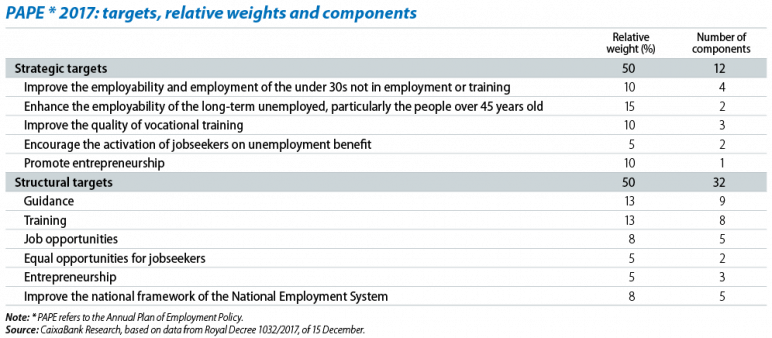Active labour market policies: a results-based evaluation
On 15 December 2017, the Spanish government passed the Spanish Active Employment Strategy (EEAE in Spanish) 2017-2020. In spite of solid growth in employment over the past four years, the EEAE highlights the important pending challenges, such as the high long-term unemployment rate, namely 50.4% of all unemployment and particularly among older workers, as well as youth unemployment which is still at a high 37.5%. It also points out the need to boost labour market participation given the country’s adverse demographic conditions, as well as improving the employability of relatively unskilled young people (young people who are neither in employment or training, called «ninis» in Spanish, accounted for 17.7% of the 16-29 age group in 2017). Strategic targets have been set to tackle these challenges. These include enhancing the employability of the most vulnerable segments, such as young people, the long-term unemployed and those aged over 55, in order to boost employment as a key means of social inclusion.
The EEAE gives continuity to the strategy approved for the period 2014-2016. The most relevant aspect of it was the modification of the criteria applied to distribute funds for managing active labour market policies among the different autonomous communities. Until2012, these funds were allocated based on the social and labour conditions of each region. However, since 2013 the allocation has also taken their performance in terms of targets achieved into account. In fact, last year for the first time all funds were allocated based on the achievement of the targets set in the Annual Plan of Employment Policy (PAPE in Spanish).1 The PAPE 2017 established a total of 44 indicators to assess how far the targets had been met (see the enclosed table).2 For instance, nine indicators are used to measure the achievement of the «Guidance» target. The aim is to assess the services provided in terms of information and professional guidance for employment and entrepreneurship by measuring, among others, the degree of coverage by information services, guidance and establishment of personalised itineraries and also how successful jobseekers are in finding employment.
This results-oriented system improves transparency and objectivity in allocating the funds to manage active labour market policies across the different autonomous communities. It also encourages a more efficient use of employment office resources. However, a close eye needs to be kept on potentially adverse effects entailed by such assessments. For example, those regions starting off in a worse position may find it more difficult to meet the targets. In such cases reducing their funding would merely aggravate the situation. Indicator design is also crucial since intangible aspects should also be measured, such as service quality, in addition to aspects such as the quantity and proportion of jobseekers benefitting from the services provided. Finally, it is also important to ensure that indicators are effectively measuring the degree to which the ultimate goals have been achieved. In this respect, it could be useful to implement programmes that regularly evaluate the effectiveness of active labour market policies ex post and, if necessary, readjust the parameters and indicators used in the assessment system.
1. The PAPE is the instrument used to programme and coordinate active labour market policies in the autonomous communities and State Employment Service (SEPE in Spanish). It has been designed as an instrument to evaluate active labour market services and schemes.
2. PAPE 2018 was presented to the autonomous communities at a Sector Conference on 21 December 2017 and is currently being revised by the Cabinet. In fact, the new EEAE has announced a commitment to approve each year’s PAPE before the year in question begins.




